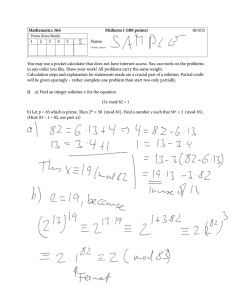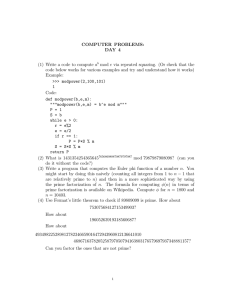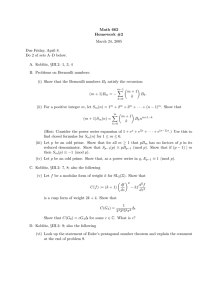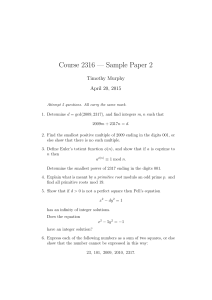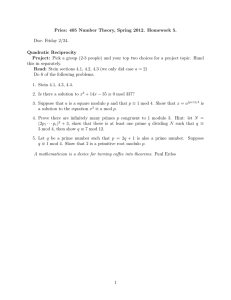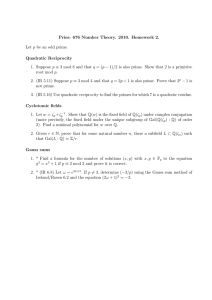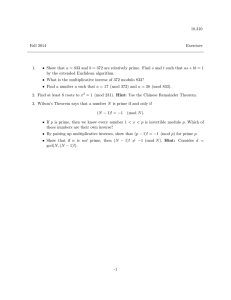Properties of Magic Squares of Squares Landon W. Rabern Roseburg, OR 97470
advertisement
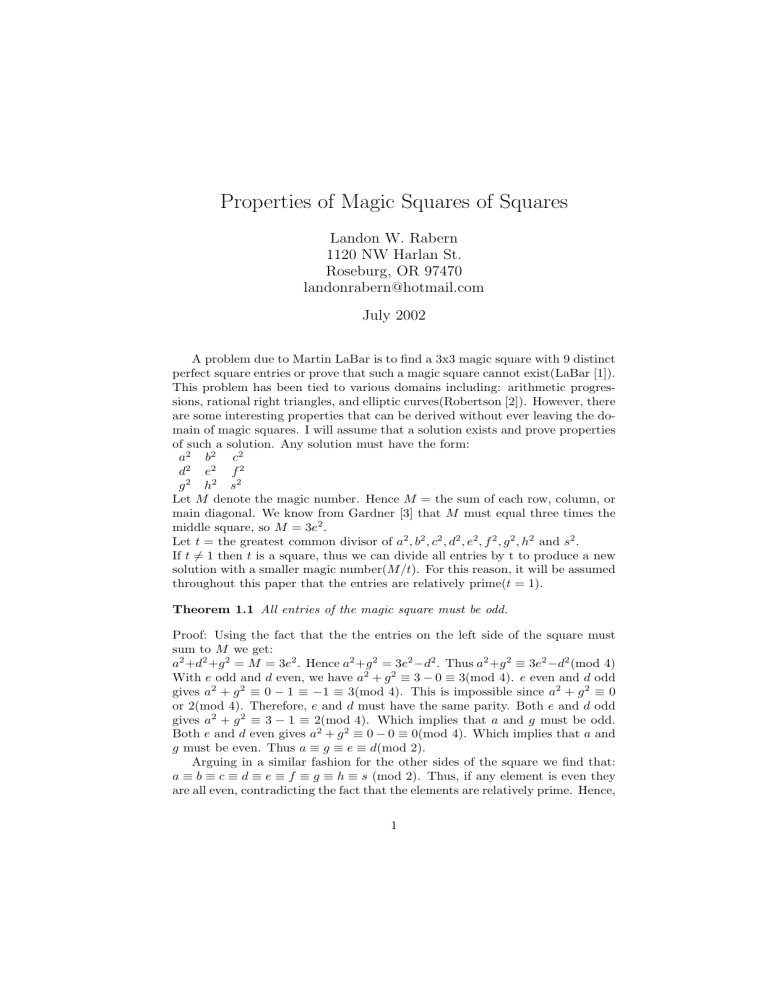
Properties of Magic Squares of Squares Landon W. Rabern 1120 NW Harlan St. Roseburg, OR 97470 landonrabern@hotmail.com July 2002 A problem due to Martin LaBar is to find a 3x3 magic square with 9 distinct perfect square entries or prove that such a magic square cannot exist(LaBar [1]). This problem has been tied to various domains including: arithmetic progressions, rational right triangles, and elliptic curves(Robertson [2]). However, there are some interesting properties that can be derived without ever leaving the domain of magic squares. I will assume that a solution exists and prove properties of such a solution. Any solution must have the form: a2 b2 c2 d2 e2 f 2 g 2 h2 s2 Let M denote the magic number. Hence M = the sum of each row, column, or main diagonal. We know from Gardner [3] that M must equal three times the middle square, so M = 3e2 . Let t = the greatest common divisor of a2 , b2 , c2 , d2 , e2 , f 2 , g 2 , h2 and s2 . If t 6= 1 then t is a square, thus we can divide all entries by t to produce a new solution with a smaller magic number(M/t). For this reason, it will be assumed throughout this paper that the entries are relatively prime(t = 1). Theorem 1.1 All entries of the magic square must be odd. Proof: Using the fact that the the entries on the left side of the square must sum to M we get: a2 +d2 +g 2 = M = 3e2 . Hence a2 +g 2 = 3e2 −d2 . Thus a2 +g 2 ≡ 3e2 −d2 (mod 4) With e odd and d even, we have a2 + g 2 ≡ 3 − 0 ≡ 3(mod 4). e even and d odd gives a2 + g 2 ≡ 0 − 1 ≡ −1 ≡ 3(mod 4). This is impossible since a2 + g 2 ≡ 0 or 2(mod 4). Therefore, e and d must have the same parity. Both e and d odd gives a2 + g 2 ≡ 3 − 1 ≡ 2(mod 4). Which implies that a and g must be odd. Both e and d even gives a2 + g 2 ≡ 0 − 0 ≡ 0(mod 4). Which implies that a and g must be even. Thus a ≡ g ≡ e ≡ d(mod 2). Arguing in a similar fashion for the other sides of the square we find that: a ≡ b ≡ c ≡ d ≡ e ≡ f ≡ g ≡ h ≡ s (mod 2). Thus, if any element is even they are all even, contradicting the fact that the elements are relatively prime. Hence, 1 all entries are odd. From all rows, columns and main diagonals that pass through the center of the square we get the following: a2 + e2 + s2 = d2 + e2 + f 2 = b2 + e2 + h2 = g 2 + e2 + c2 = 3e2 . Hence a2 + s2 = d2 + f 2 = b2 + h2 = g 2 + c2 = 2e2 We can now prove the following theorem: Theorem 1.2 The only prime divisors of e are of the form p ≡ 1(mod 4). Proof: We just need to show that no prime p ≡ 3(mod 4) can divide e. We use the fact that the ring of Gaussian integers Z[i] is a Unique Factorization Domain(UFD). Factoring the left side of a2 + s2 = 2e2 in Z[i], we get (a + si)(a − si) = 2e2 . Given an odd prime p ∈ Z, then p is prime in Z[i] if and only if p ≡ 3(mod 4)(See Lemma 1.1 in the Appendix). Thus, assume we have a p such that p ≡ 3(mod 4) and p | e. Then we must have either p | (a + si) or p | (a − si). Say p | (a + si), then a + si = pk and by complex conjugation a − si = pk = pk. Hence p | (a − si). But then p must also divide their sum and difference: p | 2si, p | 2a. Hence p | s, p | a since p is odd and real. Similarly, p | d, p | f , p | b, p | h, p | g, p | c. Hence, p divides every entry which is impossible. Theorem 1.3 If a prime p ≡ 3, 5(mod 8) divides a non-center entry then p also divides the center and the other entry in that line. Proof: Without loss of generality √ we prove the result for the a, e, s diagonal. We use the fact√that the ring Z[ 2] is a UFD. Given an odd prime p ∈ Z, then p is prime in Z[ 2] if and only if p ≡ 3, 5 (mod 8)(See Lemma 1.2 in the Appendix). a2 + s2 = 2e2 . Hence a2 = −(s2 − 2e2 ). √ We can factor√the right√side of this equation in Z[ 2] to get: a2 = −(s + e 2)(s − e 2) √ √ If p | a and √ p ≡ 3, 5(mod√8) then either p | (s + e 2) or p |√(s − e 2). Say p | (s + e√ 2), then s + e 2 = pk, and by conjugation s − e 2 = pk. Hence p | (s − e 2). √ Thus p divides their sum and difference: p | 2s, p | 2e 2. Hence p | s, p | e since p is odd and rational. Corollary 1.1 No prime p ≡ 3(mod 8) divides any entry. Proof: Say p divides some non-center entry, then by Theorem 1.3, p divides e. But from Theorem 1.2 we know that p cannot divide e since p ≡ 3(mod 8) ⇒ p ≡ 3(mod 4). Gardner [3] has shown that given any 3x3 magic square made up of distinct positive integers, there are three positive integers x, y, z so that the magic square can be written in the form: x + y + 2z x + 2y x+z x x+y+z x + 2y + 2z x + 2y + z x + 2z x+y 2 Looking at this we quickly see that d2 + h2 = 2c2 and similar relations for the other corner entries. The relation can be stated as: double a corner entry equals the sum of the two middle-side entries that are not adjacent to the corner. We can now prove the following: Theorem 1.4 No prime p ≡ 5(mod 8) divides a middle-side entry. Proof: Without loss of generality, let the middle-side entry be d2 . Again, we √ use the fact√that the ring Z[ 2] is a UFD. Given an odd prime p ∈ Z, then p is prime in Z[ 2] if and only if p ≡ 3, 5 (mod 8)(See Lemma 1.2 in the Appendix). d2 + h2 = 2c2 . Hence d2 = −(h2 − 2c2 ). √ We can factor√the right√side of this equation in Z[ 2] to get: d2 = −(h + c 2)(h − c 2) √ √ If p | d and √ p ≡ 5(mod 8) √ then either p | (h + c 2) or p |√(h − c 2). Say p | (h + c√ 2), then h + c 2 = pk and by conjugation h − c 2 = pk. Hence p | (h − c 2).√Thus p divides their sum and difference: p | 2h, p | 2c 2. Hence p | h, p | c since p is odd and rational. Since p | h we can use the same argument to show that p | f , p | a. But then, since p | f , we can use the same argument again to show that p | b, p | g. p divides both a and s, so p must also divide e. Hence p divides all entries, which is impossible. Theorem 1.5 If a prime p ≡ 3(mod 4) divides a corner entry then it divides the two middle-side entries that are not adjacent to the corner. Proof: Without loss of generality, let the corner entry be c2 . Again, we use the fact that the ring of Gaussian integers Z[i] is a UFD. Factoring the left side of d2 + h2 = 2c2 in Z[i], we get (d + hi)(d − hi) = 2c2 . If p ≡ 3(mod 4) then p is prime in Z[i](See Lemma 1.1 in the Appendix). Thus if p | c and p ≡ 3(mod 4) then either p | (d + hi) or p | (d − hi). Say p | (d + hi), then d + hi = pk, and by conjugation d − hi = pk. Hence p | (d − hi). Thus p divides their sum and difference: p | 2d, p | 2hi. Hence p | d, p | h since p is odd and real. All of these properties taken together severely restrict the possible placement of primes that are not of the form p ≡ 1(mod 8). Given these restrictions, one might conjecture that if there is a solution, then all prime divisors of all entries are of the form p ≡ 1(mod 8). This would greatly reduce the number of possibilities. It would also be interesting to disprove this conjecture by proving the opposite; namely, that any solution must have at least one entry with prime divisor p ≡ 5, 7(mod 8). APPENDIX We need √ to know when an odd prime p ∈ Z is also prime in the extensions Z[i] and Z[ 2]; the following two lemmas answer this question completely. Lemma 1.1 Given an odd prime p ∈ Z: 3 p ≡ 3(mod 4) ⇔ p prime in Z[i] Proof: Z[i] is a UFD. ⇒ Given p ≡ 3(mod 4). If p composite in Z[i] then p has a factorization p = αβ with N (α) > 1, N (β) > 1. Taking the norm of both sides we get p2 = N (α)N (β). p2 cannot divide N (α) or N (β) since this would imply N (β) = 1, N (α) = 1 respectively. Hence N (α) = p, N (β) = p. From the former we get p = N (α) = x2 + y 2 for some x, y ∈ Z. Thus p ≡ 0, 1, 2(mod 4) which is a contradiction. ⇐ Given p prime in Z[i]. If p ≡ 1(mod 4) then the equation x2 ≡ −1(mod p) has a solution. Hence x2 + 1 = kp. Factoring in Z[i] we get (x + i)(x − i) = kp. p is prime, so it must divide one of the factors and by complex conjugation it divides both. Therefore p divides their difference: p | 2i This is impossible since p is odd and real(Beukers [4]). Lemma 1.2 Given an odd prime p ∈ Z: √ p ≡ 3, 5(mod 8) ⇔ p prime in Z[ 2] √ Proof: Z[ 2] is a UFD. ⇒ √ Given p ≡ 3, 5(mod 8). If p composite in Z[ 2] then p has a factorization p = αβ with |N (α)| > 1, |N (β)| > 1. Taking the norm of both sides we get p2 = N (α)N (β). p2 cannot divide N (α) or N (β) since this would imply N (β) = 1, N (α) = 1 respectively. Hence N (α) = ±p, N (β) = ±p. From the former we get p=±N (α) = ±(x2 − 2y 2 ) for some x, y ∈ Z. Thus p ≡ 0, 1, 2, 6, 7 (mod 8) which is a contradiction. ⇐ √ 2 Given p prime in Z[ 2]. If p ≡ 1, 7(mod 8) then √ the equation x√ ≡ 2(mod √ p) has 2 a solution. Hence x −2 = kp. Factoring in Z[ 2] we get (x+ 2)(x− 2) = kp. p is prime, so it must divide one of the factors and by conjugation it divides both.√ Therefore p divides their difference: p|2 2 This is impossible since p is odd and rational. REFERENCES 1. Martin LaBar, Problem 270, College Math Journal,15, 1984, p. 69. 2. John P. Robertson, Magic Squares of Squares, Mathematics Magazine, Vol. 69, No. 4, Oct. 1996, pp. 289-293 3. Martin Gardner, Riddles of the Sphinx, Mathematical Association of America, 1987, pp. 136-137. 4. Frits Beukers, Elementary Number Theory, Lecture Notes, Sept. 2001, p. 55. Unpublished. 4


